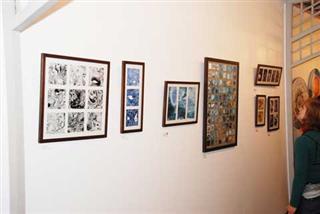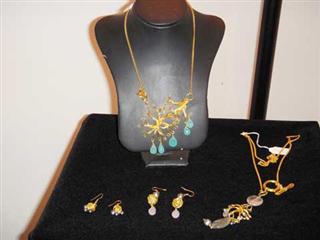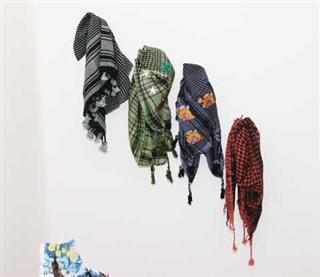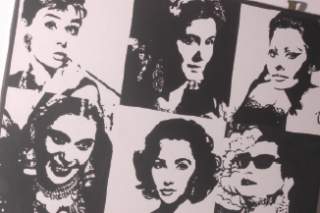It begins with a line
every time. I draw a line and it leads into a type of design, it’s not
decorative, but it’s a design. And after I’m finished I look at it and
there’s a theme that emerges,” Farida Dorra says, moving her hand to
illustrate the path of her pen across an imaginary surface. Dorra is
used to putting pen to paper and letting the ink lead the way. The
recent AUC Art graduate shared a common ambition with fellow students
Nour Omar and Heba Nawara.
“We
wanted to open a gallery that’s different, that gives a chance to all
kinds of artists, that was going to make a difference in Cairo,”
explains Omar.
This
vision, combined with the collaborative efforts of these three young
artists, gave birth to Hanfaninha, a studio gallery in Zamalek that
aims to present more than just paintings on a wall.
Hanfaninha,
which roughly translates to “We’ll make it artistic,” targets up and
coming artists, offering an inspiring alternative to Cairo’s sometimes
unwelcoming well-established galleries. “We’re trying to attract more
of the underground scene, people who don’t have a chance,” says Nawara,
stressing the difficulty of finding a venue among the precious few
scattered across downtown. Following the maxim of less is more,
Hanfaninha keeps it simple with two display areas, one long exhibition
hall and a room that can either be rented out as a studio or used for
jewelry and craft displays.
A
venue that prides itself on the diversity of its exhibitions, ranging
from video installations and scarves to ceramics and paintings, it is
only fitting that Hanfaninha had its origins in a university creativity
class. “We had to go home and think of a goal we wanted to achieve over
the next five or ten years, then present it to the class visually.”
explains Omar. Her project was a miniature gallery complete with small
print from her own work framed on tiny cardboard cut-outs. “At the
time, I didn’t know Nour that well,” recalls Dorra, “but when she
presented her idea, I thought ‘Why don’t we do something like this?’”
In
2008 Nawara, Omar, and Dorra began their search for the perfect spot to
plant their artistic flag. Finally, they settled on Villa Dorra on 41
Mohammed Mazhar St. “The house belongs to Farida’s family and her aunt
stays there sometimes,” explains Omar, but the basement and ground
floor were uninhabited, and the three artists were free to transform
them into a creative space. The transformation from cellar to studio,
however, did not happen overnight.
“On
paper it sounds easy,” says Nawara, who took a course in curating in
preparation for their opening, “but in reality it’s much more
complicated.”
Renovating the space, which hadn’t been used in nearly 30 years, proved
a challenge for the young women. “At the beginning it was such a mess,
we didn’t even want to come in,” jokes Dorra. “This room was a
nightmare,” she continues, referring to their workshop that branches
off from the craft display room. But after replacing the tiles,
repainting the aging walls and making it habitable, “we moved in our
tables, our paints, our canvases, and stayed here for four or five
months, just painting, painting, painting, with no idea as to what
would happen next.”
What
in fact happened next was Hanfaninha’s successful opening exhibition in
January 2009, showcasing paintings and drawings by Dorra, Omar and
Nawara, traditional dyed Palestinian scarves by Dana Moussa and jewelry
by Dalia Hamdallah.
The
artists had previously displayed their graduation projects side-by-side
at Falaki gallery in May ‘08, and while their style and medium of
choice vary, they share a common tendency towards original themes,
steering away from traditional forms of art.
“I
don’t do still-life,” states Omar firmly, “It always starts with an
idea or image I have in my head.” Her work deals with abstract
concepts, portrayed through the bright, elongated features of her
subjects and the splatter of acrylic paints across a boldly colored
canvas.
“We
are three very different people,” says Nawara, whose medium and style
vary according to the concept she is working with. Some of her recent
work deals with imperfection and its bizarre beauty, taking Cairo as an
example and portraying her ideas through a series of mixed-media
close-ups of old cracked walls. “They’re gorgeous; you would not
believe that this is a crack in the wall. So this is what I focused on
more, that its not a perfect city at all, it’s full of cracks,
everywhere is cracked, but that out of it you could find something very
beautiful, you could find something expressive.” Nawara openly
expresses her artistic ideas with her partners, and appreciates the
constant stream of feedback they provide. “It helps a lot because each
person brings something different,” she adds.
Dorra, on the other hand, prefers to keep her ideas to herself until
they have materialized into a finished piece. “Heba likes to take
people’s opinion, but I like to keep my stuff hidden until its
finished,” says Dorra, explaining that it is mainly to keep her
drawings free from outside influences. Dorra works solely with ink and
paper. Sometimes, her works take the form of gentle kaleidoscopic ink
patterns, swirling on the paper and resembling something from a dream.
Other times there are sharp lines, intersecting and overlapping. Some
of her more recent pieces deal with the idea of alienation and the
sanctity of private thoughts. “You could be this close to a person,”
she elaborates, “but you have no idea what is going on in their mind.”
The
three artists divulged what was on their minds, surrounded by creative
clutter and the remains of the charity exhibition “Art for a Cause,”
held at Hanfaninha in June. The two-day exhibition’s proceeds went
towards funding a local project to introduce 25 street children to
their rights under the new Child Law amendments. “We want the gallery
to go [] into the community itself. We want to have this project called
‘Hanfanin Masr’. It’s not necessarily us going out to paint the walls
in the street but we want to do more community based projects that
don’t necessarily have to be charity,” says Nawara.
“We’re
thinking of workshops, we’re thinking of going out into the street and
doing things, not just inside the gallery,” continues Omar, who
believes the local art scene is “there, but hard to see, and slowly
emerging.”
One
of the biggest obstacles to an aspiring artist is people’s
unwillingness to take art seriously. “We still have people come in and
ask ‘So this is your only job?’ Yes, believe it or not, this actually
takes up all my time,” says Omar laughingly, “we’re not only trying to
fill in the gallery gap here, but to influence the way people think,
and their attitudes towards art and the craft itself.” They appear to
have made some progress in that respect, regularly drawing an
interesting mix of art enthusiasts and curious first timers to their
shows.
Despite
their differences, these women are tied together in their joint
endeavor. “The three of us work together to curate the shows, and each
one of us has their own perspective, so when we put it together it
comes out as something new,” says Nawara. When preparing for a show,
Nawara typically handles design, Dorra organizes the events and Omar
prefers to be more hands-on, doing actual physical work. “First, we had
people helping us out with the curating, there would be people on
ladders putting up the stuff, and now it’s us — we’re on the ladders
putting up the stuff,” says Dorra.
Hanfaninha
offers artists the opportunity to hold group or solo exhibitions or to
rent out the studio for affordable prices. Showing the work of select
artists each month, Hanfaninha provides studio access and organizes an
opening exhibition including curating and advertising. Their current
exhibition displays the art of Emma James, also a former AUC student,
who has lived in Cairo for 18 years and has chosen to portray the
nuances of its culture through her paintings of Egyptian cinema icons.
Her clean, bold, Warhol-esque style puts an unlikely combination of
Fatin Hamama, Audrey Hepburn, Soad Hosni, Marilyn Monroe, Tahiya
Karioka and Sophia Loren on the same canvas and makes it work. Also
impressive was the large scale representation of Om Kolthoum, poised in
mid-song, painted in black directly on the gallery’s white wall.
Artists
who wish to exhibit must submit a one-page essay discussing their
concept along with 10–20 samples of their work. While Hanfaninha takes
technique into consideration, the young gallery owners are more
concerned with the idea and helping it develop. “If we find that there
is some potential, we sit down with the artist and collaborate with
them, discuss their theme, and try to get the whole thing working
better,” explains Dorra. “We’re looking for a combination of technique
and concept, a good balance between the two,” explains Nawara,
stressing their selectivity, “it can’t just be art that looks good.” et
Photo: A Warhol-esque portrait of legendary stars by Emma Jones, currently being shown at the gallery.
http://www.egypttoday.com/article.aspx?ArticleID=8655
------------------------------------------------------------------------------------------------------

Many
art students find themselves uncertain about their future after
graduation, torn between two unappealing options: the multinational
advertising job that will probably consume their life dry, and the
low-profile, low-income career at one of the already established art
galleries or schools. Many dream of opening up their own gallery, but
few actually succeed.
Farida Dorra, Heba Nawara, Nour Omar
were fortunate to be sharing the same passion and eagerness to turn
their dream to reality. Three months ago, the three women, all in their
early 20s, decided to turn Dorra’s basement into a lodge for not only
their artwork but for all other upcoming artists that face difficulties
finding an affordable venue to showcase their work.
“It all
started as an assignment for creativity class,” recalls Omar, who
graduated from the American University in Cairo (AUC) last spring with
a bachelor’s degree in fine arts. “We were required to come up with a
visual display of where we see ourselves in five years,” she added,
“and I realized that I want to continue doing art in a way that could
give me a stable living, without being confined in an office.”
The
class project gave birth to Hanfaninha (in Arabic 'let's make art'), a
studio gallery designed to provide artists with a place to work and a
guarantee of an exhibition venue.
In a splendid evening that
attracted mostly young socialites, fresh graduates and college seniors,
the opening of Hanfaninha Studio on Jan. 17 was a successful launch-pad
for the project, as attendees continued to stroll down its entrance for
the entire three-hour ceremony.
The venue quickly filled up with dozens of friendly faces congratulating the young artists on such “an impressive start.”
“I
think for young people to pull something together of this magnitude is
a huge undertaking,” said Kim Boyd, a Canadian who was visiting Cairo
at the time.
“It was very surprising; it exceeded my
expectations,” said Dorra, also a fresh graduate, adding that by the
end of the night, more than 20 artists filled out an application form
to be considered for the selection process that will start at the
beginning of each month.
Artists who are interested in using the
studio or showcasing their work in it will be required to submit a
short proposal of their intended project along with samples of their
work.
While applying artists will be able to use the space
to work and exhibit in return for a fixed fee (LE 700 per month for the
studio), Hanfaninha will be responsible for curation and publicity
prior to every exhibition, acquiring 15 percent of the price of sold
artworks of group exhibitions and 25 percent for solos.
“I love
it,” said Dana Moussa, commending the young artists on their
initiative. “It is a relaxed atmosphere that gives young people the
chance to work and exhibit at the same time … for very reasonable
prices.”
Moussa, a graduate of international affairs from
Northeastern University, is currently showcasing dyed traditional
Palestinian scarves (hatta) with hand-made designs patched on them.
After
hattas made their way to international fashion runways, Moussa thought
that if street vendors in Boston can make money out of classic black
and white hattas then she can probably do the same with a little twist.
Situated on the ground floor of a villa on Mohamed Mazhar
Street, Zamalek, Hanfaninha is comprised of two compartments: an
outdoor garden that leads to the gallery and a two-room indoor studio
with a kitchenette and a bathroom.
The indoor working place,
although designed to function as a space for artists to work, is aided
with sufficient lighting to be used as additional exhibiting space. The
indoor section is currently showcasing Moussa’s scarves along with a
jewelry collection by young designer Dalia Hamdallah.
Hamdallah,
an AUC graduate, is presenting a collection of earrings, bracelets and
necklaces, all combining copper with semi-precious stones creating
inimitable pieces that will surely light up any outfit.
At
the opening, the garden was studded with flower baskets leading to the
gallery, a wooden gazebo with white cloth stretched along its roof and
sides, holding the works of Amy Arif, Dorra, Nawara and Omar.
Arif, a friend of the three young artists, is also showcasing her recent collection at Hanfaninha’s first exhibition.
While
Omar’s pieces represent human interaction, the imprints people leave in
our lives and the memories that surround each of them, Dorra’s
collection includes a series of paintings outlined by lines, colors and
sequels. Dorra fuses different colors of oil paint into beautiful,
eye-soothing pieces.
Inspired by Cairo’s ordinary buildings,
Nawara watchfully portrays the cracks in the walls of the many
buildings that make up the city. The cracks, although fractured, weak
and perhaps imperfect, are a symbol of the capital, a distinguishing
feature we’ve grown accustomed to.
Arif’s collection “focuses
on the action rather than the image;” it mirrors both the creative
process of making art and the freedom of the artist’s pencil.
“I
think juniors are becoming more and more creative. It is very nice to
come see their exhibition,” said Fahima Sadek, an attendee at the
opening.
“[Their works] are quite different, very modern, very chic.”
Hanfaninha
is currently exhibiting the works of Amy Arif, Farida Dorra, Heba
Nawara and Nour Omar, as well as jewelry and scarves by Dalia Hamdallah
and Dana Moussa from Jan. 17 to Jan. 29
It is open daily from 11 am to 9 pm



Villa Dorra
41 Mohamed Mazhar St.,
Zamalek, Cairo


 Home at Hanfaninha
Home at Hanfaninha


